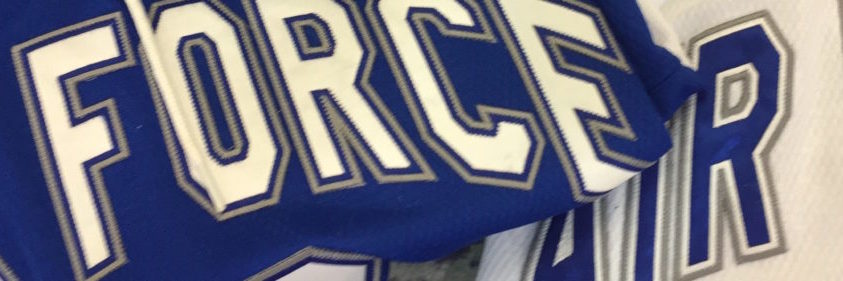If there has been one constant during Air Force’s seven runs to the NCAA Tournament in the past 12 years it can be summed up in one word – goaltending.
The Falcons, who will play top-ranked St. Cloud State on Friday (2 p.m., ESPNU), again have received excellence in net, this time from junior Billy Christopoulos.
MORE: Early look at Air Force – St. Cloud State matchup
After the departure of then-sophomore Shane Starrett to pro hockey last spring, the No. 1 question facing the Falcons centered on the position that has been beyond reproach for the most part.
“That was the big question coming into this season: Will Air Force be able to replace Starrett? Oh my goodness did we,” Falcons coach Frank Serratore said. “I don’t know if you can ever replace Starrett, but Billy did as close to it as you can.”
Christopoulos (22-14-5) started every game for the Falcons and carries a save percentage of .920 and a goals-against average of 2.08 into the NCAAs, numbers comparable to what Starrett had last season – 26-6-4, .925 and 1.99.
And just as Starrett did many times down the stretch, Christopoulos has delivered big performances at crucial times. Christopoulos shut out Army in the decisive Game 3 of an epic three-game Atlantic Hockey quarterfinal series, and then he blanked high-scoring Canisius in an AHC semifinal. His five shutouts are just as many as Starrett had a year ago.
That helped the Falcons, who were in ninth in AHC as recently as early February after an unbelievable string of injuries, go 14-4-2 in their past 20 games, including a 7-1-1 heater entering Friday’s game.
Good goaltending doesn’t happen overnight
It’s not a stretch to say the groundwork was laid for this over the past two seasons.

Billy Christopoulos
“Billy sat behind Shane Starrett for two years. Shane Starrett, a 6-foot-5 NHL prospect, athlete to the max,” Serratore said. “Shane got a lot of credit and Shane deserves all the credit. But Shane could never afford to look in the rear-view mirror because whenever he did Billy was standing right there.
“Billy was a worker, Billy competed in practice. If he didn’t play you would have never known he wasn’t the starting goalie. Billy worked his butt off for two years for this opportunity.”
That sweat equity is common theme, said former Falcons goaltender Jason Torf, who helped AFA reach the NCAA Tournament in 2011 and 2012. Torf, who is now a flying quality test engineer at Edwards Air Force Base in Lancaster, Calif., cited two factors for the Falcons’ success at the position.
“Part of it is the kind of goalies Frank recruits,” Torf said. “He finds ones that fit well. Air Force has been a juggernaut of Atlantic Hockey partially because he gets goalies who can make big saves in big moments. None of us were picked up by bigger schools except for Starrett. Every single goalie has been able to come up with huge games when they need it.
“The system plays into it. We mostly face shots from the outside and two to three times a game we’re expected to pull the rabbit out of the hat.”
If that sounds familiar, it should. Not only does Christopoulos do that, but Starrett did that, Torf did that, and so did Andrew Volkening, who led the Falcons to their first three NCAA appearances (2007, 2008 and 2009).
That leads to the second factor, Torf said.
“Frank (who doubles as the team’s goalie coach) works us to the bone,” Torf said. “We used to have goalie day every Wednesday. If those didn’t go well we had goalie day on Thursdays as well. We’d do up to 90 minutes of drills, at least 30 minutes to an hour. We’d work on stamina, footwork, positioning, the more technical aspects than what you could do when you’re going through a standard practice.
“Not all of us are Andrew Volkening. He’s 6-4, 6-5, a big guy who takes up a ton of net. To ask a goalie like me, barely 6 foot, to do that doesn’t make sense.
“Frank fixes that, so maybe you have to step out a foot because you have the speed to step back and get to the post. For me, it was working on speed or agility. That was the biggest change that Frank made to my game. Instead of playing on the edge of my crease, I was playing a foot to 2 out. It stretched me, made me improve my strength, flexibility and speed.”
Numbers don’t lie
The results were tangible. In addition to the two NCAA appearances during Torf’s career, his key stats improved from .909 to .929 and from 2.87 GAA to 1.73.
It was no different for Volkening, who went from .895 to .911 to .920 and from 2.65 to 2.09 to 1.97 in his NCAA seasons.
Big-game pressure is less daunting after goalie day, Torf said.
“Regardless of the technique and style of the goalie, the drills Frank would have us do, they work for any kind of goalie and they push any kind of goalie to develop the core attributes of flexibility, mobility and vision,” he said. “His drills are designed to stress a goalie out.”
MORE: Haak, Himley resurgence sparks Air Force offense
The coach likes to joke about his role as the Falcons’ goalie coach, a point he kidded with Christopoulos about at the post-AHC championship press conference. But in all seriousness, he credits the players and their work ethics.
“We’ve had wonderful kids to work with,” Serratore said. “We’ve been lucky to attract some good athletes. They come in and they’re very coachable. They really care, they want to be great. Look at Billy.”
And look where he’s helped the Falcons get once again.
©First Line Editorial 2017-18





